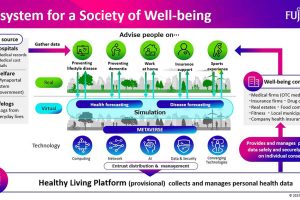How Fujitsu is Empowering Individuals to Live Healthier Lives

Overview of Fujitsu
Fujitsu, a global leader in information technology and communication solutions, has long been synonymous with innovation and excellence. Established in Japan in 1935, the company has evolved significantly over the decades, transitioning from a telecommunications equipment manufacturer to a powerhouse in IT services and solutions. With a presence in over 100 countries, Fujitsu specializes in delivering cutting-edge technology aimed at enhancing various sectors, including healthcare, finance, and manufacturing. In healthcare specifically, Fujitsu is devoted to creating smart technologies that promote better patient care. By harnessing data analytics, cloud computing, and IoT (Internet of Things) solutions, the company empowers healthcare providers to make informed decisions and improve operational efficiencies. Their commitment to sustainability and social responsibility also reflects a holistic approach to technology, prioritizing the well-being of individuals and communities.
- How Fujitsu is Empowering Individuals to Live Healthier Lives
- Overview of Fujitsu
- Importance of Living Healthier Lives
- Technology Advancements in Healthcare
- Wearable Technology
- Health Monitoring Apps
- Personalized Healthcare Solutions
- Genetic Testing Services
- Healthcare Data Analytics
- Collaboration with Healthcare Professionals
- Telemedicine Partnerships
- Remote Patient Monitoring
- Advantages of Living Healthier Lives
- Improved Quality of Life
- Reduced Healthcare Costs
Importance of Living Healthier Lives
In this age of rising health concerns, the importance of living healthier lives cannot be overstated. The shift towards healthier lifestyles emphasizes not only physical wellness but also mental and emotional health. People are increasingly recognizing that their day-to-day choices can have profound effects on their long-term health outcomes. Consider the following points which illustrate this importance:
- Increased Longevity: Research shows that healthier life choices contribute to a longer lifespan, allowing individuals to enjoy more years of vitality and activity.
- Enhanced Productivity: Healthy living is often linked to higher levels of productivity in both personal and professional settings. Individuals who maintain better health typically experience higher energy levels and improved focus.
- Emotional Well-being: Engaging in physical activities and maintaining a balanced diet are essential for regulating mood and reducing symptoms of anxiety and depression.
These facets not only elevate personal and community well-being but also help in minimizing healthcare costs. The integration of technology by companies like Fujitsu into healthcare solutions plays a pivotal role in encouraging and enabling healthier living. Through advanced tools and resources, individuals can increasingly take control of their health journeys, leading to a significant transformation in the way society approaches wellness. Embracing these innovations can pave the way for a healthier future for everyone.
Technology Advancements in Healthcare
Wearable Technology
As we embrace a healthier lifestyle, technology plays a crucial role in helping us track and improve our well-being. One of the most significant advancements in this area has been the rise of wearable technology. Devices such as fitness trackers and smartwatches have become increasingly popular, and for good reason. These wearables offer an array of functions that empower individuals to monitor their health in real time. For instance, they can track:
- Heart Rate: Many devices provide continuous heart rate monitoring, allowing users to identify trends and anomalies.
- Sleep Patterns: Quality sleep is essential for overall health. Wearables can analyze sleep cycles, helping users understand their sleep quality and adjust habits accordingly.
- Physical Activity: From tracking steps to measuring distance covered during workouts, these devices encourage users to stay active and set fitness goals.
I personally started using a fitness tracker last year, and the impact was remarkable. Not only did it motivate me to move more, but it also helped to pinpoint times when my heart rate spiked during workouts—an indication I needed to push harder. The data provided by such devices is a game-changer for anyone serious about their health.
Health Monitoring Apps
In addition to wearables, health monitoring apps are transforming the healthcare landscape. These applications provide users with the tools needed to keep track of their health metrics on the go. The convenience and accessibility of these apps make them an invaluable resource for so many. Some popular features include:
- Medication Reminders: Users can set alerts to ensure they do not miss doses, which is especially helpful for those managing chronic conditions.
- Diet Tracking: Many apps allow for easy input of food intake, making it simpler to maintain healthy eating habits by tracking calories and nutritional information.
- Symptom Tracking: Users can log symptoms daily, providing vital information that can be shared with healthcare professionals for more accurate diagnoses.
For instance, I started using a health monitoring app to keep track of my water intake and dietary habits. The app sends reminders throughout the day to stay hydrated, which has significantly improved my focus and energy levels. Together, wearable technology and health monitoring apps create an ecosystem of support, encouraging healthier living while providing essential data that both individuals and healthcare providers can rely on for better outcomes. As technology continues to advance, the potential for these tools to enhance personal health management is boundless.
Personalized Healthcare Solutions
Genetic Testing Services
As the healthcare landscape continues to evolve, personalized healthcare solutions are paving the way for more tailored approaches to individual health management. One of the most groundbreaking advancements in this area is genetic testing services. These tests analyze an individual’s DNA to provide insights into their genetic predispositions to various health conditions. Imagine being able to understand your unique genetic makeup and how it can influence your health journey. Some benefits of genetic testing include:
- Disease Risk Assessment: Genetic tests can identify at-risk markers for conditions like heart disease, diabetes, and certain cancers, allowing individuals to adopt preventive measures.
- Personalized Treatment Plans: With insights gained from genetic data, healthcare providers can recommend more effective medications and treatment plans specific to an individual’s genetic profile.
- Informed Lifestyle Choices: Knowing one’s genetic predispositions can guide personal choices related to diet, exercise, and overall lifestyle.
I recall a close friend who opted for a genetic test as part of her quest for better health. The results revealed a higher likelihood of developing osteoporosis. By understanding this risk, she was able to proactively incorporate calcium-rich foods and weight-bearing exercises into her routine, ultimately reducing her risk of developing the condition.
Healthcare Data Analytics
Another facet of personalized healthcare solutions is healthcare data analytics. This refers to the extensive analysis of health data collected from various sources, including electronic health records, wearables, and patient surveys. By leveraging advanced analytics, healthcare professionals can gain insights that lead to improved patient outcomes. Key aspects of healthcare data analytics include:
- Predictive Analytics: By analyzing historical data, healthcare providers can predict potential health issues in patients before they occur, enabling timely interventions.
- Population Health Management: Data analytics allows for tracking health trends within certain demographics, helping healthcare facilities to allocate resources where they are needed most.
- Enhanced Decision Making: Providers equipped with data insights can make more informed choices about treatment plans, leading to better patient care.
For example, a hospital might utilize predictive analytics to identify patients at risk for readmission based on their prior health data. By intervening with targeted education or follow-up care, they can significantly reduce the chances of readmission, which benefits both the patient and the healthcare system. Together, genetic testing services and healthcare data analytics are redefining how healthcare is approached. Rather than adopting a one-size-fits-all mentality, these personalized solutions empower individuals to take charge of their health in a more informed and proactive manner. As technology continues to advance, the future of personalized healthcare promises to be even more precise and impactful.
Collaboration with Healthcare Professionals
Telemedicine Partnerships
In a world where access to healthcare is paramount, technology has created innovative avenues for collaboration between patients and healthcare professionals. One of the most notable advancements in this area is telemedicine partnerships. By using virtual platforms, patients can connect with their healthcare providers without the limitations of geographical boundaries. Telemedicine has opened doors for countless individuals who may have otherwise struggled to access care due to factors such as distance, mobility issues, or time constraints. Some benefits of telemedicine partnerships include:
- Increased Accessibility: Patients residing in rural or underserved areas can now consult with specialists who may be located hundreds of miles away.
- Convenient Appointments: Virtual consultations can be scheduled more flexibly, allowing patients to manage their healthcare around their busy lives.
- Timely Care: Reduced wait times mean that patients can receive advice and treatment more quickly, which is critical for managing acute conditions.
My cousin, who lives far from major healthcare facilities, recently utilized telemedicine for a consultation about his persistent headaches. The convenience of not having to travel hours for an appointment allowed him to receive a diagnosis and treatment plan promptly. Telemedicine partnerships exemplify how technology can facilitate timely and effective healthcare delivery.
Remote Patient Monitoring
Complementing telemedicine is the growing trend of remote patient monitoring (RPM). This approach leverages technology to monitor patients’ health at home, providing real-time data to healthcare professionals. RPM has become invaluable, particularly for those with chronic conditions like diabetes, heart disease, or asthma. Key aspects of remote patient monitoring include:
- Continuous Health Tracking: Patients can use devices that monitor vital signs such as glucose levels, blood pressure, or even oxygen saturation. This continuous data stream is shared with healthcare providers for ongoing assessment.
- Proactive Interventions: By receiving real-time data, healthcare providers can identify potential issues quickly, allowing for preventive care and timely interventions before complications arise.
- Enhanced Patient Engagement: Patients who monitor their health regularly often become more engaged and informed about their conditions, leading to better management.
For instance, my neighbor recently started utilizing a blood pressure monitoring device connected to an app that shares results with her doctor. This ongoing communication helps her keep track of her condition and encourages her to make healthier lifestyle choices. Together, telemedicine partnerships and remote patient monitoring represent a new era of healthcare collaboration, enhancing patient-provider relationships while prioritizing convenience and proactive care. These advancements are shaping the future of healthcare, ensuring that individuals can receive timely and personalized support, no matter where they are located.
Advantages of Living Healthier Lives
Improved Quality of Life
Beyond the technological advancements and personalized healthcare solutions, the essence of living a healthier life comes down to the direct benefits it brings to individuals. One of the most significant advantages of adopting a healthier lifestyle is the improved quality of life. When individuals prioritize their health, the positive effects can ripple into various aspects of daily living. Living healthily can lead to:
- Increased Energy Levels: Regular physical activity and a balanced diet often translate to more energy throughout the day, making tasks, both big and small, feel more manageable.
- Enhanced Mental Clarity: Healthy living isn’t just about the body—it also supports mental health. For instance, I’ve noticed that after committing to a regular exercise routine and eating better, I feel more focused and productive at work.
- Stronger Relationships: When people prioritize their health, they tend to have more energy and enthusiasm for social interactions, leading to stronger, more fulfilling relationships.
For example, a good friend of mine made significant changes to her lifestyle by incorporating exercise and mindfulness into her routine. The transformation was remarkable—not only did she shed some extra weight, but she also became more engaged with family and friends, ultimately enhancing the quality of her social life.
Reduced Healthcare Costs
Another crucial advantage of healthier living is the potential for reduced healthcare costs. By proactively managing one’s health, individuals can mitigate the risk of chronic diseases and avoid costly medical expenses associated with treatment. Consider the following points regarding healthcare savings:
- Fewer Medical Visits: A healthy lifestyle can lead to fewer visits to the doctor, drastically reducing out-of-pocket expenses and insurance premiums. Research indicates that people who maintain regular physical activity and healthy eating habits often experience fewer health issues.
- Lower Medication Costs: With effective disease management, individuals may require less medication for conditions like diabetes or hypertension. This not only translates to lower out-of-pocket costs but can also alleviate the burden on the healthcare system.
- Long-Term Health Savings: Investing in preventive care today can yield significant savings in the future. Chronic diseases often require expensive long-term management, making early intervention crucial.
My neighbor recently shared how his decision to adopt a healthier lifestyle—complete with diet changes and regular exercise—has drastically decreased his medical bills over the past year. Not only does he feel better, but he also enjoys the added financial relief. Together, the improved quality of life and reduced healthcare costs illustrate the profound impact of living healthier lives. By embracing wellness, individuals are not only enhancing their day-to-day experiences but also ensuring a more sustainable future for themselves in terms of health and finances. It’s a win-win that anyone can aim for in their personal journey toward better living.





